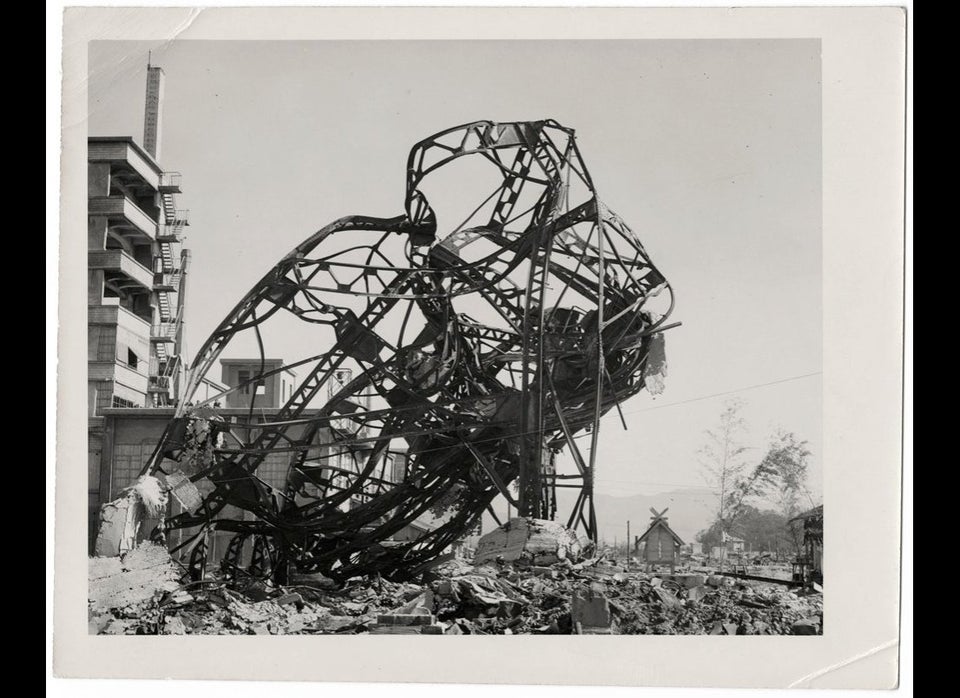What can a suitcase, found in a pile of garbage, tell us about Hiroshima and its legacy?
The suitcase was found eleven years ago by a man who was out taking his dog for a walk in Watertown, Massachusetts. Inside were 700 photographs of post-bomb Hiroshima. The images depict an annihilated city: twisted girders, imploded buildings, miles of rubble. This was the original Ground Zero, a term first used in 1946 to describe the epicenter of the blast.
1946 was also the same year that the writer Mary McCarthy called our understanding of Hiroshima "a kind of hole in human history."
Since then, accounts by survivors of the bombing have been published, documentaries have been produced and historians have fiercely debated the decision of why the bomb was dropped in the first place.
And yet the photographic record of what took place in Hiroshima has long been absent. Our lack of visual evidence of the atom bomb's effect has helped us to deny its devastating impact.
(Story continues below.)
Our culture is saturated with images of catastrophe. Think of the stream of news photographs and cell phone images of the tsunami in Japan or any number of forest fires, tornados and floods that have ripped across the global landscape. We have become accustomed, practically inured, to images of disaster. We expect to see the human cost as well - images of victims lamenting lost relatives, property and homes.
The same applies to war. Since the invention of the camera in 1839, photography has marched in lockstep with death. Starting with Alexander Gardner and Matthew Brady's images of Gettysburg, Robert Capa's photographs from the Spanish Civil War (made more potent by the camera having been freed from the tripod), through to photographs of Auschwitz after it was liberated, a series of powerful images come to mind: haunting pictures of war's destructive impact.
But think of Hiroshima and what comes to mind is the mushroom cloud. Terrifying in its way, with its bulbous head and towering stem, it is nonetheless an abstract image freed of human agency and human consequence.
That we have seen only a few images of post-bomb Hiroshima is not an accident. On September 18, 1945, just over a month after Japan surrendered, the US government imposed a strict code of censorship on the new defeated nation. They confiscated or suppressed the handful of still images taken by Japanese photographers and banned all future photography.
There was one exception. The day after Emperor Hirohito announced defeat on August 14th, President Truman commissioned the United States Strategic Bombing Survey for the Pacific Theater of War. Its mission was to "measure precisely" the impact the bomb had on the infrastructure of the city, "to put calipers on it, instead of describing it in emotive terms" as Paul Nitze, the Vice Chairman and de facto author of the Survey would later write.
A crucial, and classified, aspect of the mission was to photograph the bomb damage. Members of the Survey fanned out across the city, taking photographs that could be used to trace the bomb path and evaluate its impact on homes, hospitals and public institutions. Rarely do people appear in these images. The photographs document the shattered bones of the city.
They served a second purpose as well. An architect, Robert L. Corsbie, who was a member of the Survey, kept a set of the prints. He later worked for the Atomic Energy Commission and designed one of the first atomic bomb shelters, and in the 1950s he was involved in nuclear testing. He analyzed the impact that nuclear weapons could have on the infrastructure of our country.
He died in a house fire in 1967. The house, according to a fireman who was on the scene, "was built like a fortress" and was practically impenetrable. Yet the photographs survived, only to be accidentally abandoned on a street corner and rescued years later. They are now on view to the public.
The Strategic Bombing Survey, declassified in 1951 posed a crucial question: "What if the target for the bomb had been an American city?" The victory over Japan sowed the seeds for a new anxiety. As we prepare for the tenth anniversary of the second Ground Zero it is a fear that haunts us to this very day.
